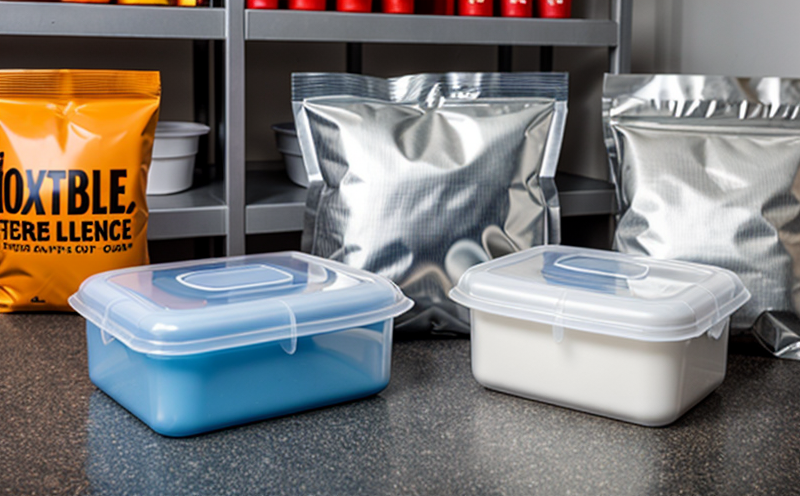ISO 11607-2 Packaging Seal Integrity Test
The ISO 11607 series of standards provides a comprehensive framework for the testing and evaluation of packaging materials. Specifically, ISO 11607-2:2015 focuses on the seal integrity test for flexible packaging. This standard is crucial in ensuring that seals remain intact during storage, transportation, and use, thereby protecting the contents from contamination or tampering.
The seal integrity test evaluates the ability of a seal to withstand potential damage caused by mechanical stress, environmental factors such as temperature changes, and physical forces applied during handling. The test aims to identify any weak points in the seal that could lead to leaks, which is particularly important for products with high value or those requiring sterile conditions.
The procedure outlined in ISO 11607-2 involves subjecting a sample of the flexible packaging material to specified stress conditions using a peel tester. This device simulates the forces encountered during opening and closing of containers. The test measures the force required to break the seal, thereby providing an assessment of the seal's strength.
For quality managers and compliance officers, ensuring that seals meet stringent standards like ISO 11607-2 is essential for maintaining product integrity and customer trust. In the R&D phase, engineers can use this test to refine materials and design more robust packaging solutions. For procurement teams, verifying supplier compliance with such international standards ensures a high-quality supply chain.
The test results provide valuable insights into the durability of seals under real-world conditions. This information is critical for optimizing storage and distribution processes, minimizing waste, and enhancing overall product safety.
- Competitive Advantage: Compliance with ISO 11607-2 ensures that your products meet global quality standards, which can be a significant differentiator in the market. It demonstrates a commitment to quality and reliability, which are increasingly valued by consumers.
- Market Impact: Adherence to international standards like ISO can enhance brand reputation and trust among customers. This is particularly important for businesses operating across multiple countries or regions that have varying regulatory requirements.
In summary, the ISO 11607-2 seal integrity test plays a pivotal role in safeguarding product quality and maintaining consumer confidence. By ensuring seals are robust enough to withstand various stresses, this standard supports the broader goals of packaging design and supply chain efficiency.
Why It Matters
The importance of seal integrity cannot be overstated in the context of flexible packaging. A compromised seal can lead to contamination or tampering, which has serious implications for product safety and consumer trust. In industries such as pharmaceuticals, food and beverage, and cosmetics, where products are subject to strict regulatory oversight, any breach in packaging integrity is a significant concern.
For instance, in the pharmaceutical sector, ensuring that vials and ampoules remain sealed during distribution prevents the risk of product contamination with harmful microorganisms. In the food industry, compromised seals on pouches or bags can result in spoilage due to exposure to air or moisture, leading to waste and loss.
The seal integrity test is part of a broader quality assurance process that includes material selection, design optimization, and manufacturing control. By incorporating this test into your quality management system, you ensure that each step of the packaging lifecycle contributes to maintaining product integrity.
Moreover, compliance with international standards like ISO 11607-2 is often a prerequisite for market access in many countries. It demonstrates that your products meet the necessary safety and quality criteria set by regulatory bodies worldwide.
Scope and Methodology
The scope of ISO 11607-2:2015 is limited to the seal integrity test for flexible packaging materials used in containers, packages, or components. This includes tests on seals formed by heat sealing, adhesive bonding, or other joining methods.
The methodology involves preparing a sample of the flexible packaging material according to specified dimensions and conditions. The sample is then subjected to a peel tester that applies a controlled force along the seal line. The test measures the maximum force required to break the seal. This value provides an indication of the seal's strength and durability.
The test can be performed in various environments, including standard laboratory conditions or under specific temperature and humidity controls, depending on the intended use of the packaging. This flexibility allows for tailoring the test parameters to reflect real-world usage scenarios accurately.
For accurate testing, it is essential to follow the exact procedures outlined in ISO 11607-2. This includes precise sample preparation, adherence to temperature and humidity conditions during testing, and careful measurement of force values using a peel tester calibrated according to international standards.





